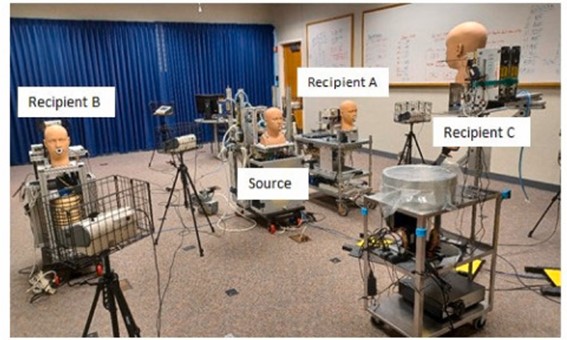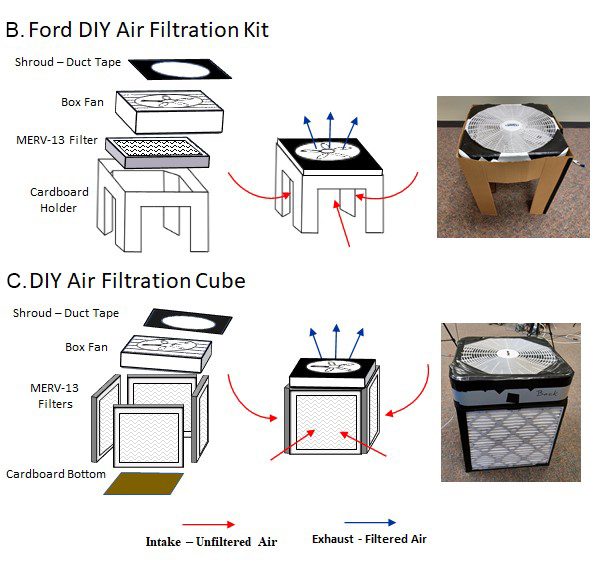The Effectiveness of DIY Air Filtration Units
Posted on by
Portable air filtration units, or air cleaners, remove airborne particles (called aerosols) from the air indoors. Air filtration units were widely used during large wildfire outbreaks in the western United States,[1] and their use surged nationwide during the COVID-19 pandemic as a way to reduce exposure to aerosols containing the SARS-CoV-2 virus. Homemade or Do-It-Yourself (DIY) air filtration units are an alternative to commercially produced products that can be made from supplies available at local hardware stores. DIY units became popular during the pandemic due to supply shortages and the high costs of HEPA air cleaners. However, comprehensive evaluations of how well these units reduce exposure to aerosols in a real-world scenario have been limited. New research from the National Institute for Occupational Safety and Health (NIOSH) examined the effectiveness of DIY air filtration units in reducing exposure to simulated respiratory aerosols in a mock classroom.
Background
NIOSH researchers used a speaker-audience model to examine the effectiveness of two popular types of DIY air filtration units, the Corsi-Rosenthal cube and a modified Ford air filtration unit. Using a custom-built respiratory aerosol simulator that breathes and exhales aerosol particles (called the source) and three breathing simulators (called recipients), researchers studied the combined effects of the room ventilation system, DIY air filtration units, and human respiratory activities on exposure to respiratory aerosols (see Figure A).
Figure A.

The Tested Designs
The Ford Motor Company and Lasko Products, LLC developed and produced a simple DIY air filtration kit and shipped 20,000 units to organizations in underserved communities, including school districts in Los Angeles, New York City and throughout Southeast Michigan to help slow the spread of COVID-19. [2] The kits consisted of a cardboard box that contained a 20” (51 cm) box fan, a 20” x 20” x 2” (51 × 51 × 10 cm) minimum efficiency reporting value (MERV) 13 filter and a set of instructions to convert the box into a holder for the fan and filter (Figure B). [3]
Dr. Richard Corsi (Dean of Engineering at the University of California, Davis) and Jim Rosenthal (CEO of Tex-Air Filter) created an air filtration unit made with five filters taped together to form a cube with a box fan taped to the top. The use of multiple filters reduced the airflow resistance and greatly increased the amount of air flowing through the filtration unit.[4] This air filtration device with five filters was dubbed the “Corsi-Rosenthal Box” or CR Box, and a version using four filters was dubbed the “Comparetto Cube” (Figure C). 4 For this study, the four-filter version was tested.
To build the units for testing, NIOSH researchers purchased and evaluated seven box style fans based on commercial availability. Two fans with the highest and lowest airflow rates were used in the DIY unit configurations. Each model was constructed using commercially available 1” (2.5 cm) or 2” (5 cm) deep MERV 13 filters. The DIY air filtration units were tested with the central HVAC system set at 2 air changes/hour to represent a classroom with low ventilation.

Results
The research revealed that:
DIY air filtration units can be an effective means of reducing aerosol exposure. The DIY units reduced aerosol exposure up to 73% depending on the design of the DIY unit, filter thickness, and fan airflow.
Several significant factors affect the reduction in aerosol exposure produced using DIY air filtration units.
- Increasing the MERV 13 filter thickness, which increases the surface area of the filters and allows more air to flow through them (see discussion on fan airflow below), resulted in significantly lower aerosol exposures for both types of DIY air filtration units. The 2” (5 cm) filters have more than twice the surface area of the 1” (2.5 cm) filters, thereby filtering more air.
- So why not use even thicker filters? While the modified Ford DIY unit can use thicker filters relatively easily, using filters thicker than 2″ (5 cm) in the DIY cubes would require a more complex design diminishing the construction simplicity of the unit. The original Ford DIY air filtration units used 4” (10 cm) thick filters and likely would have provided better performance than the modified version used in the study. The thinner 1” (2.5 cm) and 2” (5 cm) filters used in the modified design are widely available commercially and represent filters that would be typically used by the public to construct DIY units.
- The number of filters in the design of the units had a significant impact on aerosol reduction, due to the increase in the total surface area of the filters. The DIY air filtration cube with four 2” (5 cm) filters had a combined surface area of 48.7 ft2 (4.52 m2) compared with 12.2 ft2 (1.13 m2) for the modified Ford DIY air filtration unit with a single 2” (5 cm) filter. Because of this increased surface area, the DIY cube was better at reducing exposure among the recipients.
- The fan airflow rate had a significant effect on exposure reduction. The fan with a higher airflow rate consistently outperformed the fan with the lower airflow rate. Unfortunately, only a few fan manufacturers provide fan specifications including airflow rates on their products, making it difficult to determine which fans to use when constructing a DIY air filtration unit.
- Using two DIY units instead of one increased air mixing and produced a more uniform reduction in aerosol concentration.
Noise is an important consideration when using a DIY air filtration unit in a classroom setting. Unfortunately, fans with higher flow rates and on higher settings tend to be noisier. When single units were operated on low speed, 5 out of 7 fans were below the ANSI maximum background noise level of 50 dB, while only one unit was below the limit on high speed.
The effects of combining the use of face masks and the DIY cubes were also studied. When DIY cubes were operated without masks on the recipients, the relative exposure was reduced by 59% to 78% depending on filter thickness and fan speed. When the source and all recipients wore face masks (universal masking) but no filtration units were used, the relative exposure for recipients was reduced by 75%. However, when recipients were universally masked and the DIY cubes were operating, the relative exposure was reduced by 88% with 1” (2.5 cm) filters and the fan on low, and by 94% with the 2” (5 cm) filters and the fan on high.
Finally, the results showed that performance of DIY units can vary considerably depending upon their design, construction, and positioning of the units. Currently there are no standards for constructing DIY units, which has led to several variations in designs that can significantly influence their effectiveness. Many filter models are available commercially with a wide range of filtration efficiencies, and with no standard filter recommendations, units constructed by the public will inevitably vary greatly in performance. Additionally, potential problems with construction quality such as leaks and gaps could substantially affect the performance of DIY air filtration units. Furthermore, most people building a DIY unit will not have access to the specialized equipment and knowledge needed to test if the unit is working as intended.
Limitations
This research used static simulators which did not move around the room, did not contain a heated body source, and did not exhale breaths of warm and humid air that would create a thermal plume, all of which could influence the airflow pattern and aerosol dispersion for the recipients. Rooms with different dimensions and airflow patterns from the study room also would likely have different results. Finally, the study focused on small aerosol particles which are most likely to remain airborne and spread throughout the room, but humans also expel much larger particles which can also carry viruses.
Conclusions/Tips
DIY air filtration units may be effective for temporary use until commercial portable air cleaners with known performance characteristics can be acquired, or used in areas that cannot obtain commercial portable air cleaners. However, the EPA does not recommend the DIY units as a permanent alternative to products of known performance (such as commercially available portable air cleaners).[5]
Tips for making an efficient DIY air filtration unit.
- Use high quality MERV-13 filters. Lower MERV rated filters are not as effective at filtering airborne particles, especially smaller ones.
- Use 2” filters in the DIY unit rather than 1” filters.
- DIY units with more filters or thicker filters give the best performance.
- Use the highest airflow possible. Increased airflow equals more filtration.
- The DIY units should be constructed with a fan shroud (see Figures B and C). The shroud keeps air from recirculating in the fan and greatly improves the performance of the unit.
- Make sure all filter to filter and fan to filter joints are sealed.
- Any holes in the fan chassis should be sealed.
Raymond Derk, MS; Jayme Coyle, PhD; William Lindsley, PhD; Francoise Blachere, MSc; Angela Lemons, MS; Samantha Service, MS; Steven Fotta; Jeffrey Reynolds, PhD, PE; Walter McKinney, MSEE; Erik Sinsel, MS; Donald Beezhold, PhD; and John Noti, PhD; are with the NIOSH Health Effects Laboratory Division.
Stephen Martin Jr., PhD, PE, is with the NIOSH Respiratory Health Division.
Kenneth Mead, PhD, PE, is with the NIOSH Division of Field Studies and Engineering.
References
[1] R. Xu, P. Yu, M.J. Abramson, F.H. Johnston, J.M. Samet, M.L. Bell, A. Haines, K.L. Ebi, S. Li, Y. Guo [2020]. Wildfires, global climate change, and human health. N. Engl. J. Med., 383 (22): 2173-2181.
[2] Ford Media Center [2021]. Ford DIY Air Filtration Kit that Reduces COVID-19 in the Air validated by peer-reviewed scientific research journal. Press release May 12, https://media.ford.com/content/fordmedia/fna/us/en/news/2021/05/12/ford-diy-air-filtration-kit-covid-19-validated.html
[3] Ford Media Center [2021]. How to Assemble a COVID-19 Air Filtration Box Fan Using the Downloadable Template. https://media.ford.com/content/dam/fordmedia/North%20America/US/2021/02/02/Air-Filtration-Box-Fan-Template.pdf
[4] J. Rosenthal [2021]. IAQ Research-Practice in Action: the Corsi/Rosenthal Box Air Cleaner, July 24, https://www.texairfilters.com/iaq-research-practice-in-action-the-corsi-rosenthal-box-air-cleaner/
[5] EPA [2022]. Air cleaners, HVAC filters, and coronavirus (COVID-19), April 4, https://www.epa.gov/coronavirus/air-cleaners-hvac-filters-and-coronavirus-covid-19
Posted on by

